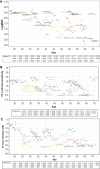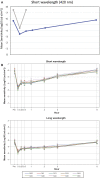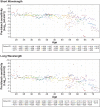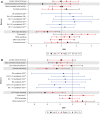Retinal Dystrophy Associated With RLBP1 Retinitis Pigmentosa: A Five-Year Prospective Natural History Study
- PMID: 37883093
- PMCID: PMC10615144
- DOI: 10.1167/iovs.64.13.42
Retinal Dystrophy Associated With RLBP1 Retinitis Pigmentosa: A Five-Year Prospective Natural History Study
Abstract
Purpose: To assess the progression in functional and structural measures over a five-year period in patients with retinal dystrophy caused by RLBP1 gene mutation.
Methods: This prospective, noninterventional study included patients with biallelic RLBP1 mutations from two clinical sites in Sweden and Canada. Key assessments included ocular examinations, visual functional measures (best-corrected visual acuity [BCVA], contrast sensitivity [CS], dark-adaptation [DA] kinetics up to six hours for two wavelengths [450 and 632 nm], Humphrey visual fields [HVF], full-field flicker electroretinograms), and structural ocular assessments.
Results: Of the 45 patients enrolled, 38 completed the full five years of follow-up. At baseline, patients had BCVA ranging from -0.2 to 1.3 logMAR, poor CS, HVF defects, and prominent thinning in central foveal thickness. All patients had extremely prolonged DA rod recovery of approximately six hours at both wavelengths. The test-retest repeatability was high across all anatomic and functional endpoints. Cross-sectionally, poorer VA was associated with older age (right eye, correlation coefficient [CC]: 0.606; left eye, CC: -0.578; P < 0.001) and HVF MD values decreased with age (right eye, CC: -0.672, left eye, CC: -0.654; P < 0.001). However, no major changes in functional or structural measures were noted longitudinally over the five-year period.
Conclusions: This natural history study, which is the first study to monitor patients with RLBP1 RD for five years, showed that severely delayed DA sensitivity recovery, a characteristic feature of this disease, was observed in all patients across all age groups (17-69 years), making it a potentially suitable efficacy assessment for gene therapy treatment in this patient population.
Conflict of interest statement
Disclosure:
Figures






References
-
- Bernal S, Calaf M, Adan A, et al. .. Evaluation of RLBP1 in 50 autosomal recessive retinitis pigmentosa and 4 retinitis punctata albescens Spanish families. Ophthalmic Genet. 2001; 22: 19–25. - PubMed
-
- Burstedt MS, Sandgren O, Holmgren G, Forsman-Semb K.. Bothnia dystrophy caused by mutations in the cellular retinaldehyde-binding protein gene (RLBP1) on chromosome 15q26. Invest Ophthalmol Vis Sci. 1999; 40: 995–1000. - PubMed
-
- Burstedt MS, Jonsson F, Kohn L, et al. .. Genotype-phenotype correlations in Bothnia dystrophy caused by RLBP1 gene sequence variations. Acta Opthalmol . 2013; 91: 437–444. - PubMed
-
- Hipp S, Zobor G, Glockle N, et al. .. Phenotype variations of retinal dystrophies caused by mutations in the RLBP1 gene. Acta Ophthalmol. 2015; 93: e281–e286. - PubMed
Publication types
MeSH terms
LinkOut - more resources
Full Text Sources
Miscellaneous

